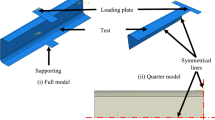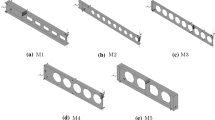Abstract
In this paper, the web crippling strength of cold-formed steel plain channel beams subjected to concentrated loads is evaluated on the basis of numerical models and available test results. The design equations existing in current steel codes display many coefficients, have not theoretical background and overlook the slenderness concept, which is a trademark of safety checking rules related with other failure modes such as column flexural-torsional buckling, web shear buckling and plate buckling. The main objective is to show that such slenderness-based approach is possible for web crippling design. Firstly, some considerations about the web crippling of cold-formed steel beams are drawn and a brief review is made. Secondly, the equations for web crippling design available in current Eurocode 3 and AISI steel codes are described. Then, the numerical model is explained in detail. On the basis of numerical and experimental results, it is shown that an approach based on the slenderness concept leads to fairly good estimates of web crippling load. Finally, some conclusions are drawn.
Similar content being viewed by others
References
AISI (1996). Specification for the Design of Cold-Formed Steel Structural Members. American Iron and Steel Institute, Washington, DC.
AISI (2007). North American Specification for the Design of Cold-formed Steel Structural Members. American Iron and Steel Institute, Washington, DC.
AS/NZS 4600 (1996). Cold-Formed Steel Structures, Standards of Australia and Standards of New Zealand Sydney, Wellington.
Beshara, B. and Schuster, R. M. (2006). “Web crippling data and calibrations of cold formed steel members”. AISI Research Report RP00-2, Washington, DC.
CEN (2006). Eurocode 3: Design of Steel Structures. Part 1–3: General rules. Supplementary rules for cold-formed members and sheeting. European Committee for Standardisation, Brussel.
CSA S136-94 (1994). Cold formed steel structural members. Canadian Standards Association Toronto, Canada.
Duarte, A. P. C. (2011). Development of a new approach for the design of cold-formed steel beams against web crippling failure. MSc. Dissertation in Civil Engineering, Instituto Superior Técnico, Technical University of Lisbon (in Portuguese).
Encarnação, R. J. A. (2009). Analysis and design of coldformed steel beams against web crippling failure. MSc. Dissertation in Civil Engineering, Instituto Superior Técnico, Technical University of Lisbon. (in Portuguese)
Hetrakul, N. and Yu, W. W. (1978). Structural behaviour of beam webs subjected to web crippling and a combination of web crippling and bending, Final Report, Civil Engineering Study 78-4, University of Missouri-Rolla, Rolla, Missouri.
Johansson, B. and Lagerqvist, O. (1995). “Resistance of plate edges to concentrated forces.” Journal of Constructional Steel Research, 32(1), pp. 69–105.
Lagerqvist, O. and Johansson, B. (1996). “Resistance of Igirders to concentrated loads.” Journal of Constructional Steel Research, 39(2), pp. 87–119.
Parabakaran, K. (1993). Web Crippling of Cold Formed Steel Sections. Project Report, Department of Civil Engineering, University of Waterloo, Waterloo.
Rhodes, J. and Nash, D. (1998). “An investigation of web crushing behaviour in thin-walled beams.” Thin-Walled Structures, 32(1–3), pp. 207–230.
Schafer, B. W., Li, Z., and Moen, C. D. (2010). “Computational modeling of cold-formed steel.” Thinwalled Structures, 48(10–11), pp. 752–762.
Simulia (2007). ABAQUS Standard. User’s Manual. Version 6.7. Rhode Island, USA.
Sivakumaran, K. S. (1989). “Analysis for web crippling behaviour of cold-formed steel members.” Computers & Structures, 32(3–4), pp. 707–719.
Timoshenko, S. P. and Gere, G. M. (1961). Theory of Elastic Stability. 2 nd Ed., McGraw-Hill, New York.
Walker, A. C. (1975). Design and Analysis of Cold Formed Sections. Jhon Wiley & Sons, New York.
Winter, G. and Pian, R. H. J. (1946). “Crushing Strength of Thin Steel Webs.” Engineering Experiment Station, Bulletin 35, Cornell University, New York.
Xiao, R. Y., Chin, G. P. W., and Chung, K. F. (2002). “Testing and numerical analysis of cold-formed Csections subject to patch load.” Advances in Steel Structures — Proc. 3rd International Conference on Advances in Steel Structures, Chan S. L., Teng J. G., Chung K. F. (Eds), pp. 351–356.
Young, B. and Hancock, G. J. (2001). “Design of coldformed channels subjected to web crippling.” Journal of Structural Engineering, 127(10), pp. 1137–1144.
Zetlin, L. (1955). “Elastic Instability of Flat Plates Subjected to Partial Edge Loads.” Journal of the Structural Division, 81, pp. 1–24.
Zhou, F. and Young, B. (2007). “Experimental and numerical investigations of cold-formed stainless steel tubular sections subjected to concentrated bearing load.” Journal of Constructional Steel Research, 63(11), pp. 1452–1466.
Author information
Authors and Affiliations
Corresponding author
Additional information
Note.-Discussion open until February 1, 2014. This manuscript for this paper was submitted for review and possible publication on January 14, 2013; approved on May 31, 2013.
Rights and permissions
About this article
Cite this article
Duarte, A.P.C., Silvestre, N. A new slenderness-based approach for the web crippling design of plain channel steel beams. Int J Steel Struct 13, 421–434 (2013). https://doi.org/10.1007/s13296-013-3003-4
Published:
Issue Date:
DOI: https://doi.org/10.1007/s13296-013-3003-4




